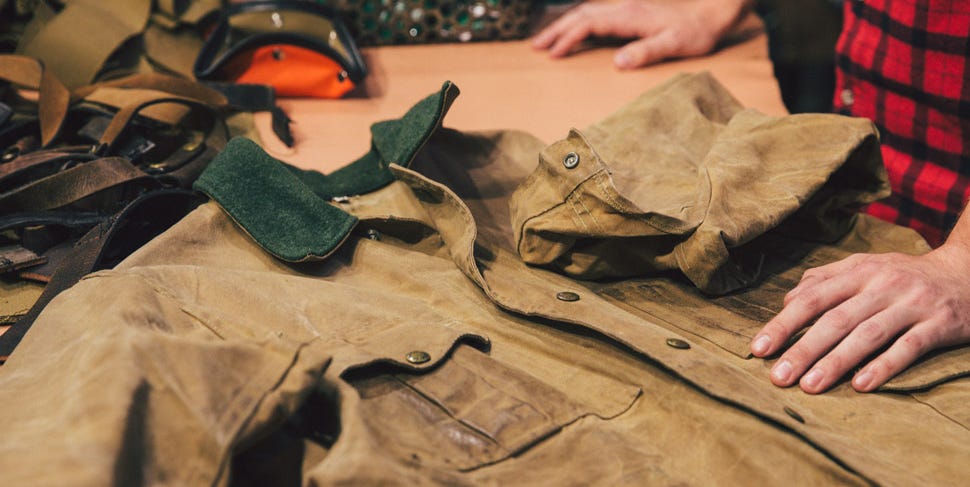Before synthetic fabrics, before Gore-Tex and “weatherproof breathability”, there was heavy cotton and a pot of wax. The early sailors realized that wet sails caught the wind better than dry sails, but wet sails were too heavy and slowed ships.The solution was to apply oil to the sailcloths, which made them more effective and also water repellent so that they stay light in the rain. The primitive designs, made from linseed oil, stiffen in the cold and fade. Then, in the early 20th century, manufacturers developed a process for impregnating cotton with paraffin wax. for soft, warm, durable and waterproof clothing. which was quickly adopted by soldiers, outdoor enthusiasts and sailors.
Since then, a plethora of synthetic, breathable and waterproof fabrics have been developed and used in these lightweight North Face jackets that everyone wears. But a few companies have stuck with waxed cotton, which remains much more suited to work wear and carries the look and story of a true outdoor enthusiast; don’t expect the paper-thin liner of your standard synthetic zipper to survive a stray edge when you chop down a tree.
One of those companies is Filson, who started in Seattle in 1897 outfitting prospectors en route to the Klondike Gold Rush. The company still offers waxed cotton jackets to its customers – their flagship jackets are made of thick pewter fabric, named after the days when pewter was the strongest and most commonly used metal. A few years ago, we caught up with Michael Skauge – then Filson’s retail operations manager in New York – to learn how to wax a heavy cotton jacket. Follow below.
Clean and prepare your jacket
You can tell that a jacket needs to be re-knitted by its appearance. The areas where the wax has been worn will appear lighter than the oily, dark stains around the seams and indentations. Presumably, if you need to wax your jacket again, you’ve worn it outside, so you might want to clean it before waxing it again. However, Skauge cautions that you shouldn’t normally attempt to clean the jacket as “spot cleaning will lighten some areas as the wax is washed off.”
So if you want to get rid of the dirt and odor after a season of use, the best solution is to soak the whole jacket in cold water or rinse it completely. Not use soaps or detergents. This is not your t-shirt; machine washing a wax jacket damages the material.
Apply wax
After the jacket is dry, put it on a table and take a can of paraffin wax or soy wax (soy wax is usually used on lighter jackets); wax jackets are normally sold with the correct wax. Some guides will tell you to heat the wax and use a paintbrush to brush it off, but this is a jacket, not a number paint. Skauge simply suggests using your hands to work this wax into the jacket.
“The warmth of your hand helps loosen the wax. Paraffin melts at about 100 degrees and changes [it’s actually 99 degrees]so your body heat will release it and your hand will work it into the fabric, ”Skauge said as he rubbed wax into his own jacket. “It’s something you can do in the field, but not below 40 degrees without warming it up somehow. You could use a camping stove.
Heat the applied wax
Heating the wax will melt it into the cotton fibers, completely saturating the fabric. Oddly, this step is optional; Just be aware that unheated waxed jackets are lighter in color and look a bit chalky once the wax has dried. After a little use, the limescale will wear off and you will end up with a lighter “dry jacket”.
However, it is recommended to heat the jacket for maximum durability and wax saturation. Skauge uses a heat gun at full power to work in the wax, but a hair dryer will work, he says – it will just take longer. A fully waxed and heated jacket will appear dark and have a sheen similar to leather.
Dry, wipe and wear it
Once you are happy with the rewrapping, hang the jacket up to dry overnight. In the morning, your jacket will be a little oily. It’s OK; you just smell the excess wax. This means that the tin canvas is completely saturated and you have done your job correctly.
“At the molecular level, once it soaks in, you’ll have oil on top because the oil is draining out of the jacket. If you don’t want it, you can wipe it off with a dry cloth or literally water it down, ”Skauge said.
That’s it. It’s a surprisingly simple process. Skauge says to re-wax each year or as needed, and that their store offers washing and rewaxing services if you want help with the process.
Shop for a selection of waxed jackets, waxes, and heat sources below (including the same heat gun as Skauge).
Waxed flannel lined trucker jacket
1800W heat gun (122 ℉ ~ 1202 ℉)
1875 Watt Pro Ceramic Hair Dryer
This content is created and maintained by a third party, and uploaded to this page to help users provide their email addresses. You may be able to find more information about this and other similar content on piano.io









